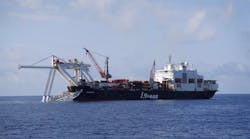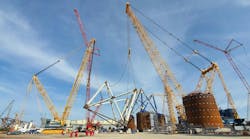Robert Pawlowski - Chevron Energy Technology Co.
Ricardo Fernandez - Fugro Chance de Mexico
In this first in a series forOffshore, we take a close look at the geopolitical and geotechnical aspects/issues associated with cross-border oil fields. First, Javier H. Estrada Estrada (Analítica Energética) illuminates some of the chief issues and hurdles facing the development of cross-border oil fields. Other aspects of GoM-wide geology, development, and innovation will be addressed in future installments of the series.
Early 2009 witnessed the installation of the topsides for the Perdido development regional host spar (partners BP, Chevron, Shell) in the ultra deepwater (> 5,000 ft or 1,500 m) of Alaminos Canyon protraction area block 857 (US sector of the Gulf of Mexico). ThePerdido spar, moored in some 2,380 m (7,800 ft) of water, will act as the main hub and gathering/processing/exporting center for the nearby Great White, Tobago, and Silvertip fields of Alaminos Canyon. Perdido can provide access to other discoveries within a 48 km (30 mi) radius, and is designed to produce as much as 100,000 b/d of oil and 200 MMcf/d of natural gas (130,000 boe/d). Great White, Tobago, and Silvertip, set to produce in 2010 from the Perdido Fold Belt structural trend, will constitute the first commercial offshore production from deepwater Gulf of Mexico Lower Tertiary reservoirs (Paleogene Wilcox section) – the so-called Lower Tertiary Play, a prospective and regionally extensive sand fairway present on both sides of the US-Mexico border.
In Alaminos Canyon protraction area, the BAHA 1 (1996) and BAHA 2 (2001) wells first established the presence of elements critical to a working deepwater GoM Lower Tertiary petroleum system. The Trident well (2001) proved the potential for commercially viable quantities of Lower Tertiary hydrocarbons. Great White (2002), Tobago (2004), Tiger (2004), and Gotcha Deep (2006) Lower Wilcox discoveries followed.
Exploratory drilling in US waters has extended the deepwater Lower Tertiary Play several hundred miles eastward from the original Alaminos Canyon discoveries into the adjacent Keathley Canyon (e.g., Kaskida, 2006; Buckskin, 2009) and Walker Ridge (e.g., Cascade, 2002; St. Malo and Chinook, 2003; Jack, 2004; Stones, 2005; Julia, 2007) protraction areas.
In US GoM waters, the deepwater Lower Tertiary Wilcox Trend currently hosts over one dozen discoveries having (together) potential recoverable reserves of approximately 3 Bboe. The Perdido Fold Belt discoveries in Alaminos Canyon, mere miles north of the US-Mexico international maritime boundary, dramatically spotlight the significant upside potential for additional equally impressive discoveries not only in US waters, but also in Mexican waters just to the south. In fact, Pemex has identified similar geology and drill prospects in Mexican waters south of the Alaminos Canyon protraction area, including prospects Magnánimo (2,520 m or 8,268 ft water depth), Alaminos (2,888 m or 9,475 ft) Máximino-1 (2,891 m or 9,485 ft), Pep-1 (2,940 m or 9,646 ft of water), Chachiquin (3,216 m, 10,551 ft), and Afótica (3,350 m, 10,991 ft).
Unfortunately, the impressive discoveries being racked up on the US side of the border contrast severely with the lack of deepwater drilling in Mexican waters just south of the border, a situation exasperated by the longstanding lack of drilling access (i.e., production sharing) by non-Mexican oil-company operators – this in spite of 13 years of declining oilfield production in Mexico (as exemplified by the declines at the giant Cantarell field).
On a slightly more positive note, the recent October 2008 Mexican oil reform opens the door slightly wider for possible increased involvement by international oilfield service companies (already active and vitally integral to Mexico’s oil industry). The 2008 oil reform also may strengthen Pemex by increasing public oversight and strengthening Pemex’s internal governance and efficiency.
One issue not adequately addressed by existing frameworks for US-Mexico cross-border relations is the development of fields that truly straddle the border, or fields whose development has the potential for draining hydrocarbons from one side of the border to the other. In this context, it is interesting to note that the 2001 Trident discovery in US waters is only about 3 mi (4.8 km) north of the border.
The energy security of the United States and Mexico are intertwined. The Mexican government depends upon oil export revenues for approximately 40% of its fiscal budget. If Mexico cannot reverse its production decline, it soon will become a net oil importer. That is not in the economic and security interest of Mexico, nor in the geopolitical interest of the United States. Not only is Mexico a friendly hemispherical neighbor of the US, it is the second largest supplier to the US after Canada (year-to-date information through February 2009 from US Energy Information Administration).
The next few years will be telling. For 2009, PEMEX has a record investment budget equal to approximately $19.4 billion (roughly double that of recent years). It remains to be seen how offshore border zone development factors into Pemex’s exploration and production plans as discoveries on the US side continue to mount up.




